Author: Ignas, DeFi Research
Translator: J1N, Techub News
There are ample reasons to be bearish on Ethereum in the current market. Since the market low in early 2023, SOL has outperformed Ethereum by 6.8 times, and the ETH/BTC trading pair has seen a decline of 47% over the past two years.
Is it time for Ethereum to rebound?
Bearish Reasons for Ethereum
There are various reasons for Ethereum's underperformance, but I believe several key reasons are as follows:
Bitcoin is considered "digital gold," a concept that is easily understood by both retail and institutional investors. In contrast, Ethereum's narrative is more complex. Referring to it as "digital oil" is neither appealing nor accurate in the market's eyes.
Solana is catching up to, and even surpassing, Ethereum in terms of active users, trading volume, and awareness.
When investors choose which cryptocurrency to invest in, Bitcoin is seen as the safer choice, while Solana is considered a lower market cap option with potential. Ethereum falls somewhere in between.
Ethereum's modularity and L2 have fragmented liquidity and complicated the user experience.
The modularity requires investors to diversify their funds across various derivative tokens on Ethereum, such as multiple L2, LRT tokens, and DA tokens. In contrast, on Solana, users only need to purchase SOL in similar situations.
I believe Ethereum's performance will surpass that of Bitcoin because the market recognizes the high returns of the POS mining mechanism. Based solely on the airdrop returns of the re-staking protocol, I believe Ethereum's current price is severely undervalued.
However, this has not led to a FOMO effect for Ethereum, possibly due to the overexposure and traffic Ethereum's ecosystem received during the previous bear market period, leading many to believe that Ethereum will not fail and to buy in large quantities.
In contrast, there are few Crypto Native holders of SOL. When SOL rebounds, these individuals are more likely to shift their funds from Ethereum to SOL. Without a significant influx of retail funds, Ethereum's price remains stagnant.
Another issue is the decrease in Ethereum's staking rewards and burn rate.
Following the EIP-4884 Proto-danksharding upgrade, L2 gas fees on Ethereum have decreased, leading to a reduction in Ethereum's burn rate. Although Ethereum's inflation rate remains below 1%, this situation is not optimistic for those who see Ethereum as "ultrasound money."
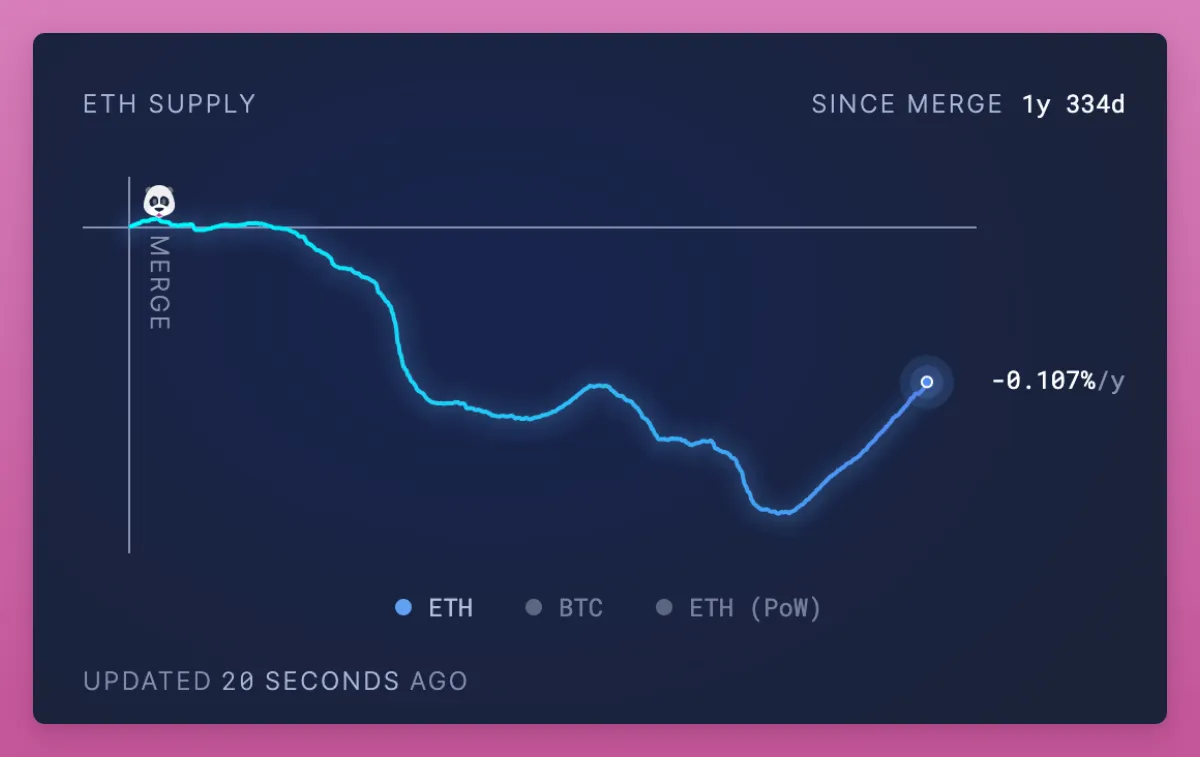
It is clear that after the release of EIP-4844 in March, there has been a reversal in Ethereum's burn trend.
Currently, there are few "ultrasound money" Memecoins on Twitter. Bearish sentiments flood Twitter, but bullish sentiment for Ethereum still exists, albeit not as strong as for Bitcoin.
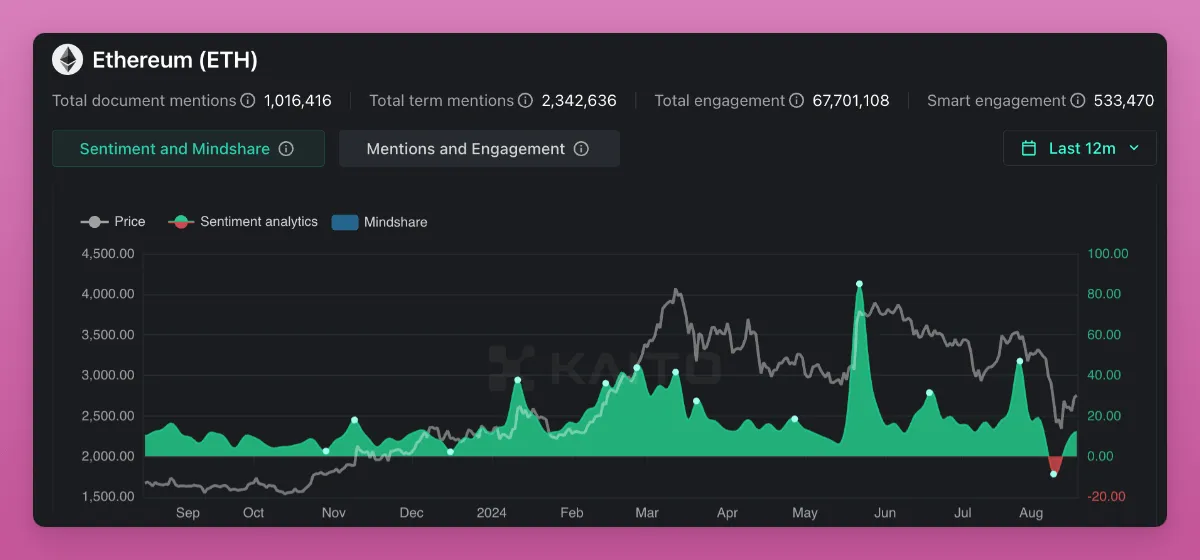
On the contrary, let's discuss the bullish points for Ethereum.
Bullish Points for Ethereum
There are many reasons to be bullish on Ethereum, and I asked fans on Twitter to share their views.
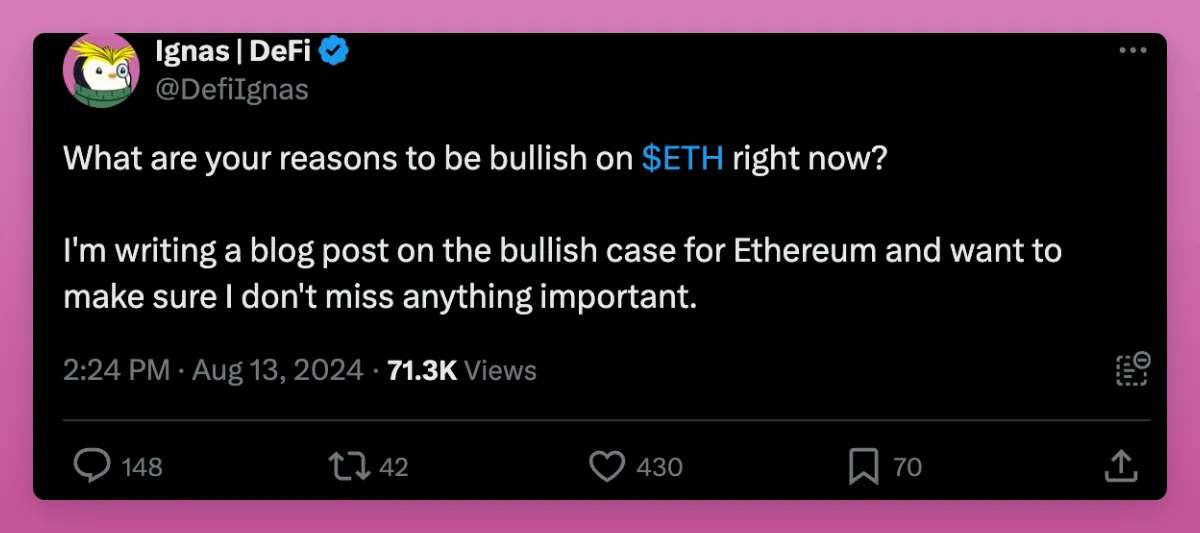
Before sharing, I summarized everyone's views into the following 10 points.
If gas prices remain around 20 Gwei, Ethereum will experience deflation, making it an attractive and efficient network. It is worth noting that since March, Ethereum's gas prices have consistently been below 20 Gwei.
Retail investors can now stake Ethereum from home, attracting individual investors with consumer-grade hardware and increasing the network's decentralization.
The strong developer community and emerging new ideas in Ethereum's ecosystem support ongoing innovation and network robustness.
Ethereum is the leader in smart contract platforms, ensuring decentralization while maintaining reliability, without any real competitors.
Continued development in L2 and interoperability improvements are major positive factors, while the community is working to optimize fragmentation and improve network efficiency.
Regulatory transparency is increasing, especially in the United States and the European Union, enhancing market confidence in Ethereum and enabling institutions like BlackRock to adopt Ethereum.
Various LSD protocols allow all Ethereum holders to participate in network protection without technical knowledge or resources.
Large institutions such as Coinbase and BlackRock have indicated that tokenized real-world assets (RWA) on Ethereum will become increasingly popular.
DeFi services and large stablecoin pools on Ethereum have significant growth potential.
Ethereum holders and users have regained enthusiasm and collective pride, contributing to blockchain advocacy and market education.
I also asked several prominent Ethereum holders and users why they are bullish on Ethereum. Camila Russo (Founder of The Defiant) and Christine Kim (Galaxy Researcher) responded.
Here are Camila Russo's reasons for being bullish on Ethereum:
Mature DeFi ecosystem: Ethereum and its second-layer networks have the most mature DeFi ecosystem in the entire cryptocurrency space. This liquidity and DApp concentration will attract more users, to the point where the impact of DeFi activities will be reflected on L1, thereby increasing gas fees and consuming more Ethereum. DeFi is crucial because finance is one of the few meaningful cryptocurrency use cases.
Decentralization and security: Ethereum's decentralization and security have already attracted the world's largest asset management institutions. Institutions such as BlackRock's BUIDL Fund, PayPal's PYUSD, JPMorgan Chase, Santander Bank, and other major banks are testing blockchain settlement and tokenization functions on Ethereum. Large institutions cannot afford the risk of blockchain downtime or validator/miner attacks and violations, so they will continue to choose Ethereum. This will drive activity development and price increases.
Ethereum spot ETF: Ethereum is one of only two cryptocurrencies that institutional investors in the United States can invest in through ETFs, providing long-term support for Ethereum's price.
Christine Kim emphasized Ethereum's network effects:
I believe one of Ethereum's main advantages compared to its competitors is its network effects. Ethereum is the earliest general-purpose blockchain with a first-mover advantage and the largest developer community, both of which I believe contribute to increasing the network's value.
In fact, I am more willing to store long-term assets on Ethereum. Solana has experienced multiple failures, while Ethereum has been reliable for many years.
Furthermore, I am very bullish on Ethereum as a risk-weighted asset chain for the tokenization of real-world assets. For example, 52% of stablecoins and 73% of US Treasury bonds have been tokenized on Ethereum.
If you are bullish on Memecoins, Solana might be your choice, but for the tokenization of billions of dollars in RWA, Ethereum is the safest choice.
Next, a big issue is the second layer.
Solana, as a large all-in-one public chain, is fast and reasonably priced, but still has shortcomings.
The modular expansion of L2 provides a long-term solution, as modular expansion can be customized for specific application scenarios, providing more flexibility, simplicity, and cultural sovereignty for L2. Cygaar articulates this well in the post below:

Currently, due to reliance on cross-chain bridges, liquidity is dispersed, leading to a poor user experience, but hopefully this is temporary. For example, Catalyst AMM will allow atomic swaps between different chains, eliminating the need for bridged assets. In this scenario, liquidity remains dispersed, but users can still obtain the best prices as liquidity comes from multiple chains. More solutions like Catalyst are in development.
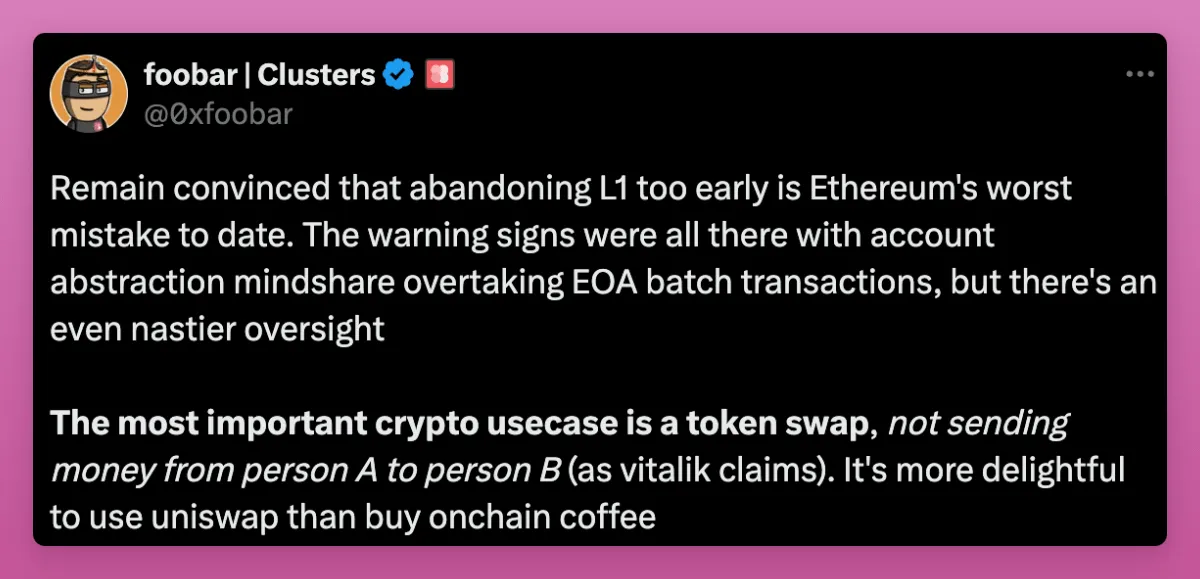
Additionally, L2s themselves are making greater efforts.
Optimism is "integrating with ERC-7683 to allow superchains to interoperate with other parts of Ethereum L2 through the application layer," meaning all L2s in the Optimism ecosystem will become a whole.
Similarly, Polygon is building an AggLayer, "which means one-click transactions across chains. It will recreate the on-chain experience."
Then there's Caldera's Metalayer, Avail Nexus, and Hyperlane.
Even though various aggregation solutions have not yet been implemented, with ongoing development, future liquidity and user experience issues should be resolved.
I believe people underestimate the speed at which this trend is happening. I recommend following Andy on Twitter for the latest developments in modular expansion.
Also, read this Blocmates article to understand how to solve the current issues with multiple products.
In fact, Vitalik himself has stated that people will be surprised to find that "cross-L2 interoperability" is no longer a problem.
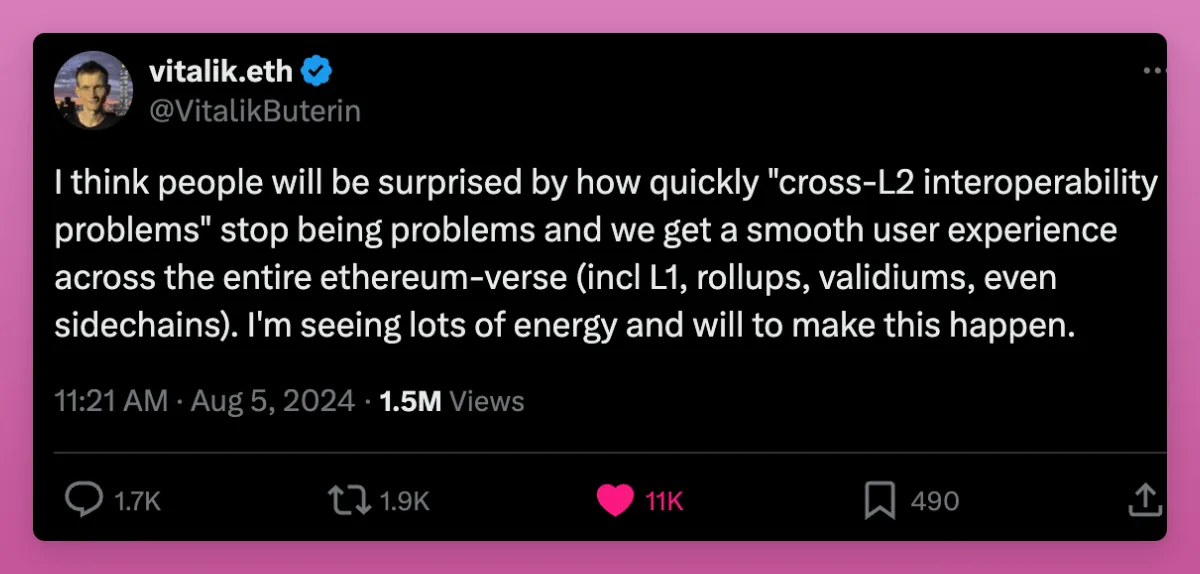
If you need to see more bullish viewpoints and reasons, check out Emmanuel's post below. He is bullish on Ethereum because of its strong community, ongoing innovation, and long-term adaptability.

If the L2 fragmentation issue is resolved and RWA and tokenization applications continue to grow on Ethereum, I would be very bullish on Ethereum, but these are long-term factors.
In the short term, there is a bullish point that few people are discussing: the Pectra upgrade.
What is the Pectra upgrade?
The Pectra upgrade is the next major milestone in the Ethereum upgrade roadmap, expected to be launched in the first quarter of 2025. It combines the Prague (execution layer) and Electra (consensus layer) updates.
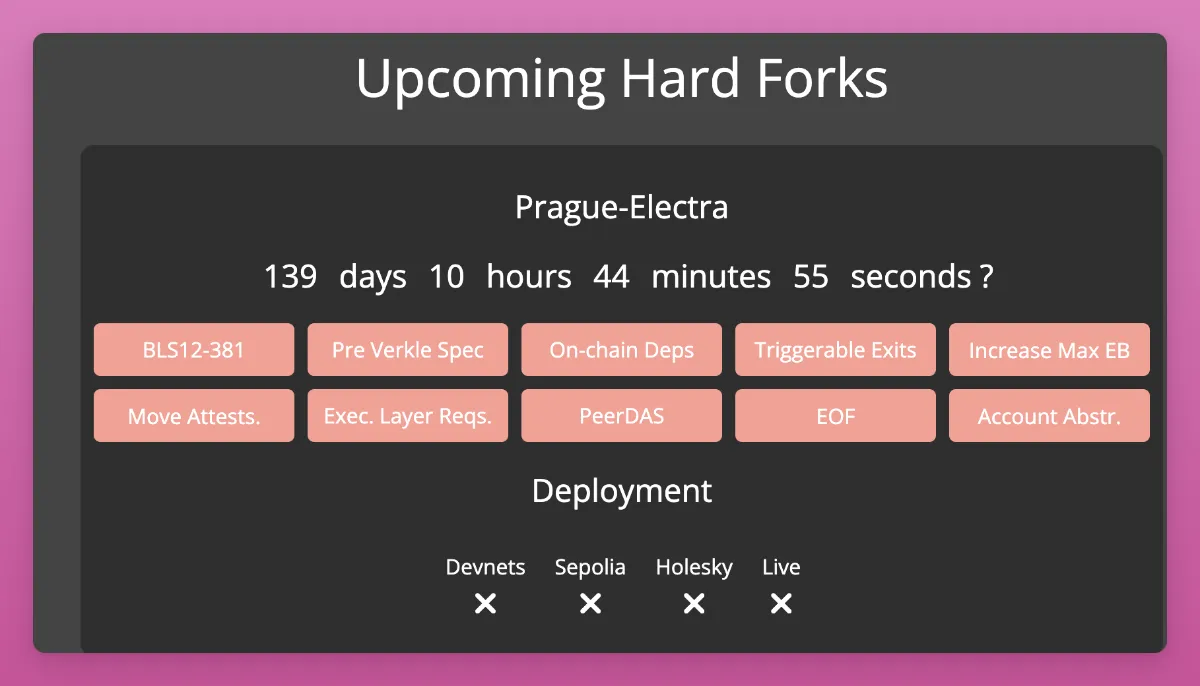
Previously, all major Ethereum upgrades received significant attention, but the Pectra upgrade seems to be receiving little market attention.
I understand why. Ethereum has undergone significant changes in the past: from PoW to PoS migration, Ethereum burn initiation, and EIP-4884, among others. While the scale of the Pectra upgrade may not be as large as previous upgrades, it still has some interesting updates.
1. Account abstraction: Ultimately improving user experience
One of the biggest changes in the Pectra upgrade is the way accounts are handled.
Currently, managing wallets involves many cumbersome steps, from signing transactions to managing transaction fees across different networks. The Pectra upgrade simplifies the entire process through account abstraction.
EIP-3074 and EIP-7702 are two proposed improvements. EIP-3074 allows traditional wallets (externally owned accounts or EOAs) to interact with smart contracts, enabling batch transactions and sponsored transactions, for example.
EIP-7702 goes further, allowing EOAs to temporarily act as smart contract wallets during transactions. "Temporary" means that your EOA wallet becomes a smart contract wallet only during the transaction. It works by adding smart contract code to the EOA address. Let's look at the ideal scenario:
Directly swapping USDC for UNI in a single interaction without needing to approve.
DApps can pay gas fees on behalf of users.
Pre-approve DApps that users want to use with the wallet and set spending limits.
Vitalik's EIP-7702 seems to prioritize EIP-3074, and EIP-7702 is also compatible with AA implementation.
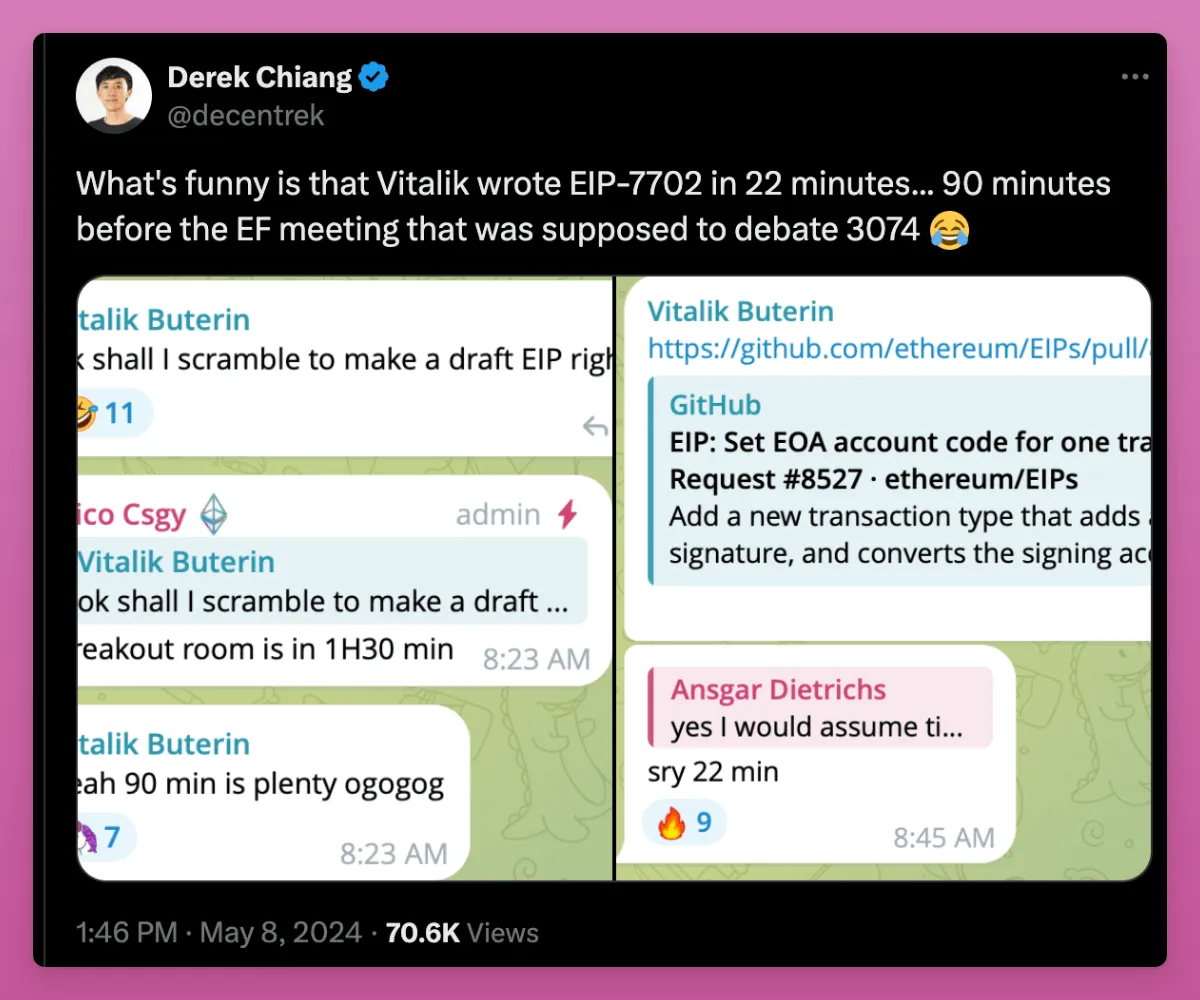
The idea of "EOA temporarily becoming a smart contract" is cool because current DApps are often incompatible with smart account wallets (trying to use Safe or Avocado multisig with DApps). Hopefully, AA will receive more attention after the upgrade.
2. Staking optimization
The Pectra upgrade brings significant changes for users running validators.
EIP-7251 increases the maximum staking amount for validators from 32 ETH to 2048 ETH. It allows large stakers to consolidate their stakes, reduce the number of validators, and lighten the network load.
This is also a positive for smaller stakers, as it provides more flexible staking options (e.g., staking 40 ETH or compounding rewards). Additionally, the Ethereum staking queue will be reduced from several hours to a few minutes.
One major highlight that excites me is related to MEV mitigation, but it seems it will not be implemented in the Pectra upgrade.
3. Scalability improvements
Pectra introduces PeerDAS (Peer Data Availability Sampling) through EIP-7594.
Like the Proto-Danksharding in the previous Dencun upgrade, PeerDAS will bring lower gas fees on L2. However, I cannot find data on how much cheaper it will be (I think PeerDAS will be particularly useful during periods of high usage). 0xBreadguy mentioned that the Pectra upgrade will increase blob capacity by 2-3 times.
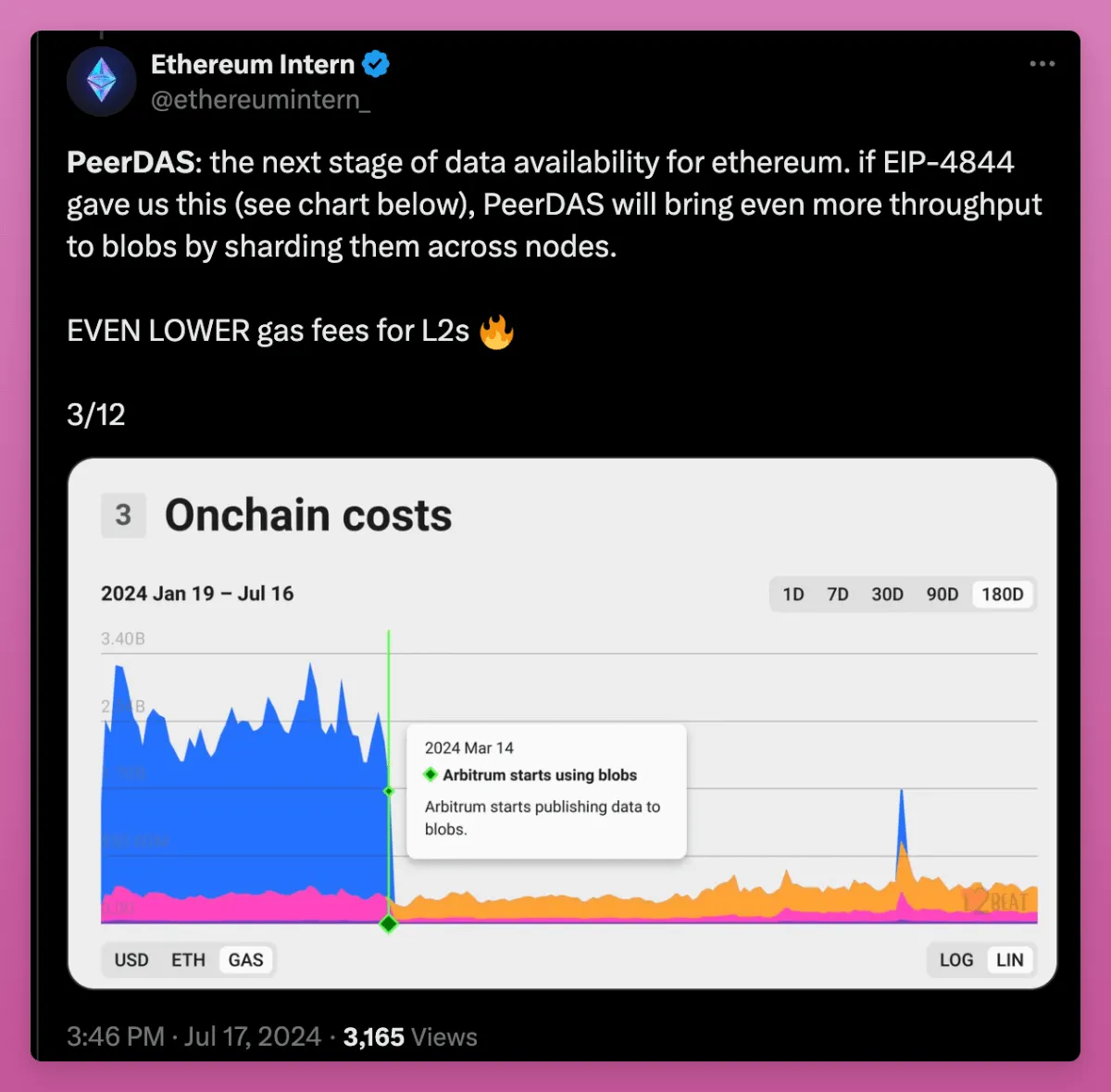
There are also several technical upgrades, such as BLS12-381 to shorten BLS signatures (reducing gas costs), and EIP-2935 to verify transactions without the need for blockchain history.
These EIPs, along with the Verkle Trees Transition (EIP-6800) that will eventually replace the existing Merkle Tree structure, can make lightweight clients more secure and make it easier for nodes to participate in the network, thereby increasing decentralization.
One major change is the modification of the EVM, which, through 11 EIP standards, will make it easier to write and deploy smart contracts, reducing costs and increasing efficiency. In other words, development on Ethereum will become smoother.
This tweet from Ethereum Intern succinctly explains the impact of the technical upgrades.
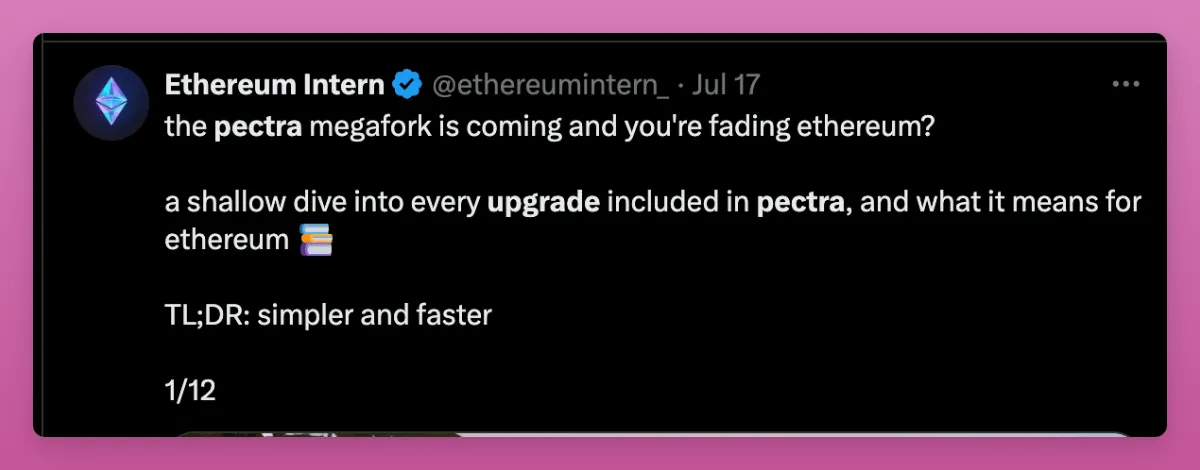
I am pleased that Single Slot Finality (SSF) is finally being introduced with the Pectra upgrade, but it is not included in the upcoming Osaka upgrade.
In December 2023, Vitalik shared that SSF is the simplest way to address most of the flaws in Ethereum's PoS design.
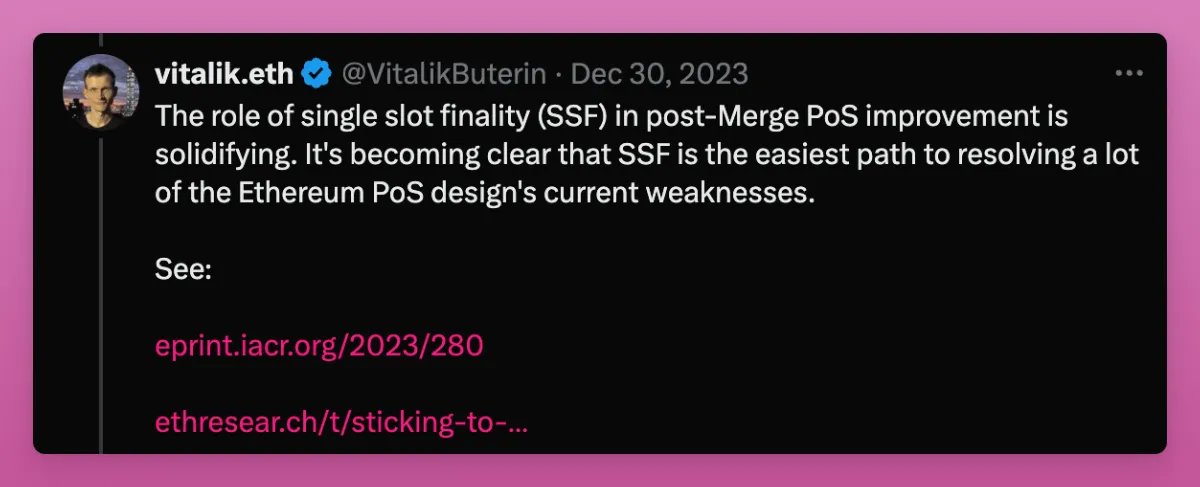
Currently, Ethereum's proof-of-stake consensus mechanism takes about 15 minutes to finalize a block, meaning that without substantial economic penalties, the block cannot be changed or removed. SSF aims to shorten this time to a single slot, approximately 12 seconds, ensuring that blocks are almost immediately finalized after creation.
In practical terms, this means faster and more secure bridging, as well as faster deposits to CEX. It is disappointing that this has not been implemented yet. The fact that this is not included in the upgrade is disappointing because it indicates that Ethereum developers still do not prioritize first-level scaling.
Nevertheless, the Pectra upgrade is a technical upgrade, but I believe the market underestimates its importance.
Now, let's talk about Ethereum's price.
VanEck predicts that by 2030, the price of Ethereum will reach $11,800.
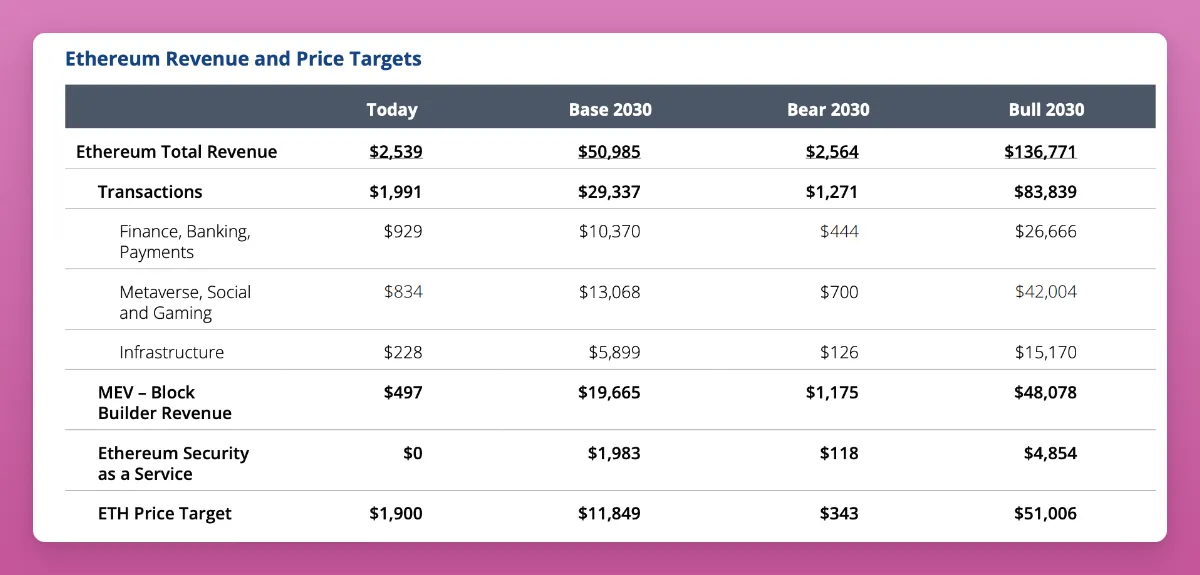
To be honest, a price of $11,800 is quite conservative (I hope Ethereum's price will be higher), but remember that VanEck predicts that by 2030, the price of Solana will only be $335.
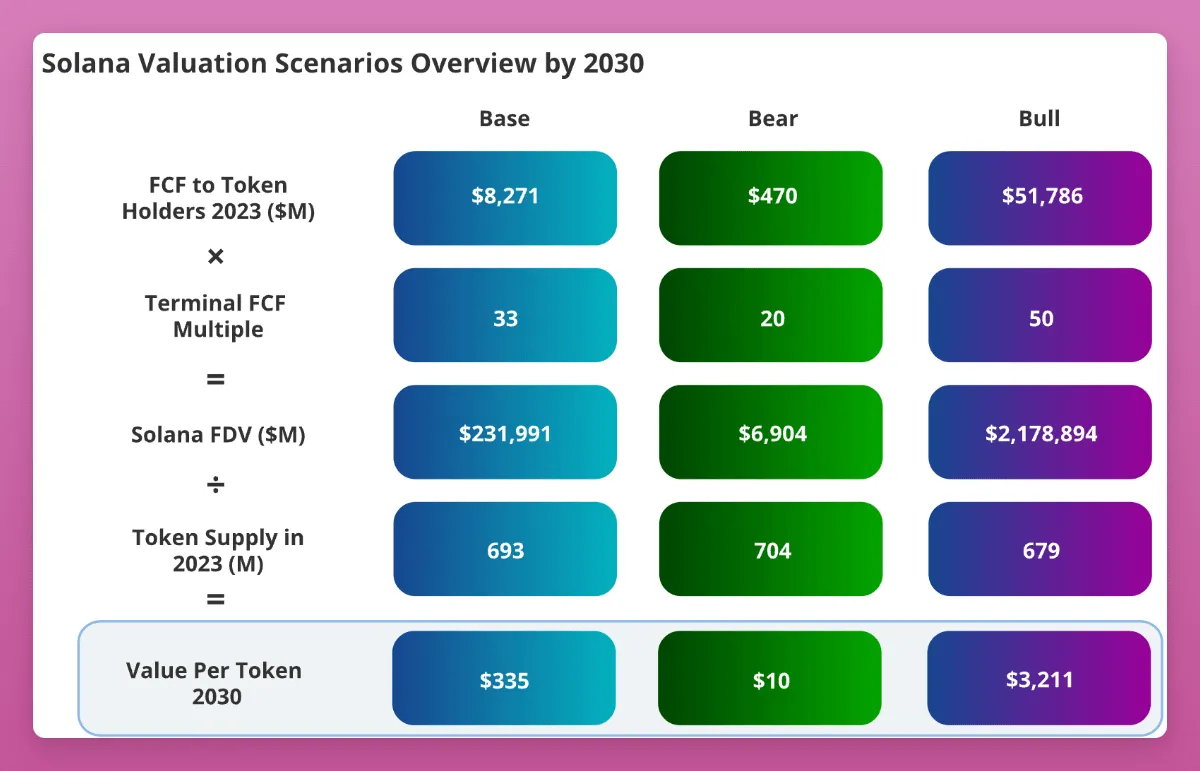
Therefore, based on fundamental predictions, Ethereum's potential is 4.4 times, while SOL is only 2.2 times. Please note that both of these predictions were made a year before the launch of the Ethereum ETF, so I am eager to see their latest predictions.
By the way, if you need more bullish viewpoints, Ark Invest CEO Cathie Wood expects that by 2030, Ethereum will reach $166,000, and Bitcoin will reach $1.3 million.
However, I find VanEck's bullish Ethereum price prediction of $51,000 by 2030 to be realistic. VanEck's Ethereum price prediction is based on:
- VanEck expects Ethereum to occupy 70% of the market share in the smart contract platform by 2030, leveraging its first-mover advantage as a global blockchain settlement network.
- Ethereum's revenue is expected to grow from $2.6 billion annually to $51 billion by 2030. This growth is attributed to transaction fees, increased MEV, and the introduction of "security as a service" (SaaS), using Ethereum staking to protect other protocols (restaking).
- Ethereum is expected to capture more economic activity in finance, banking, payments, metaverse, social, gaming, and infrastructure.
- Ethereum's potential as a store of value is recognized, with its usability enhanced by smart contract programmability and cross-chain messaging technology.
Here is a summary of the scenarios in the base, bear, and bull markets.
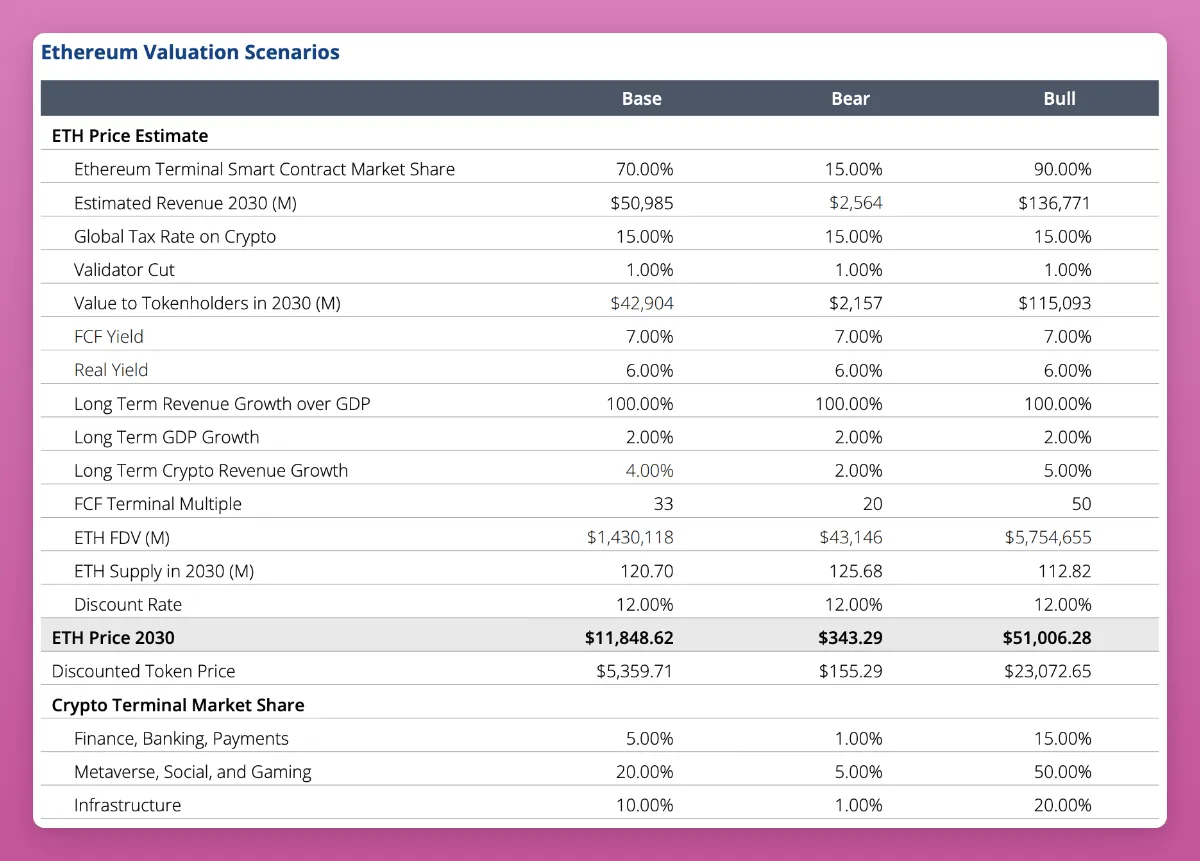
In my opinion, Ethereum's 70% dominance in the smart contract platform is quite reasonable, although Ethereum's current dominance is only 58%, but including all L2 markets, it is about 65%. Despite the crazy rise of SOL, Ethereum's dominance has remained unchanged since early 2022.
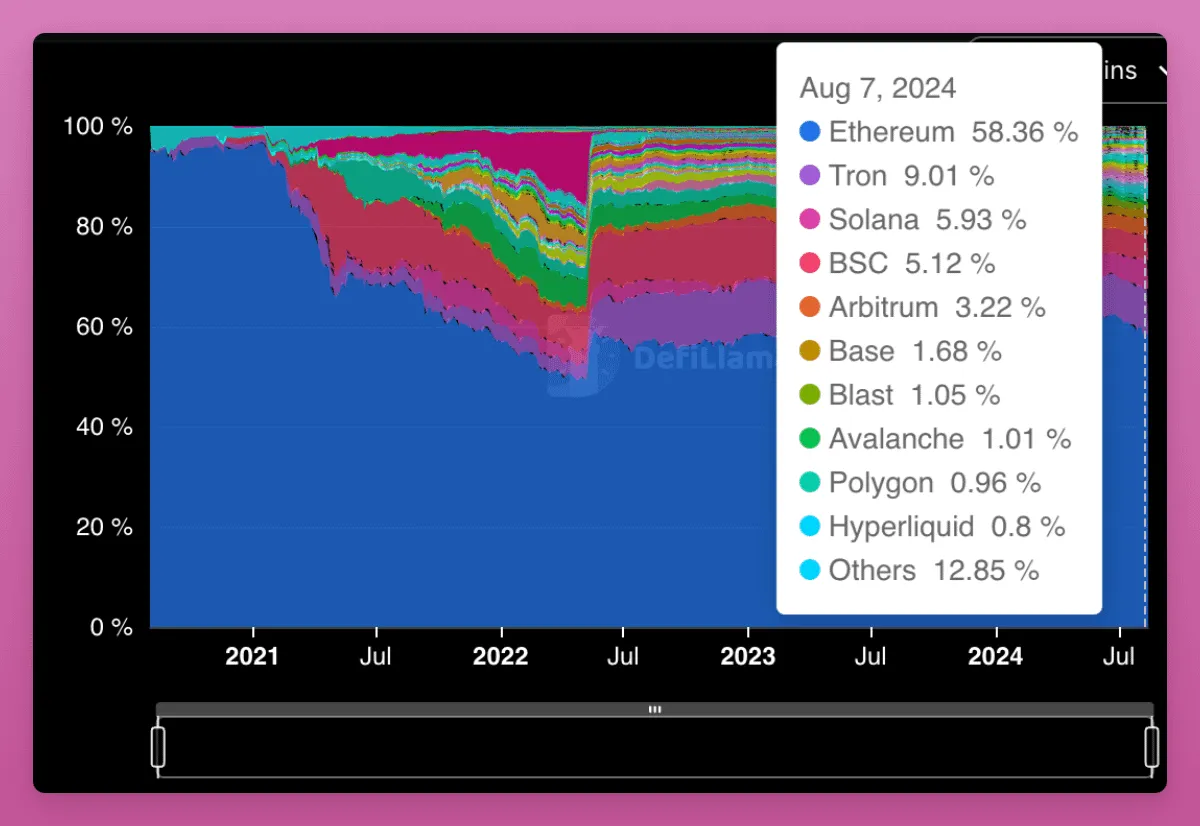
The TVL ratio will be a key indicator, as institutions are more concerned about this metric.
Another metric that both institutional and retail investors are watching is the flow of Ethereum spot ETF.
Ethereum Spot ETF
If someone had told me a few months ago that Ethereum had a spot ETF, but the trading price was below $3,000, I would have thought the market was in a bear market.
It's still too early to draw conclusions, but the Ethereum spot ETF seems to be increasingly bullish. The outflow rate of funds from Grayscale is rapidly decreasing, and the net flow has been positive for three consecutive days. It seems that those who needed to exit Grayscale have already done so.
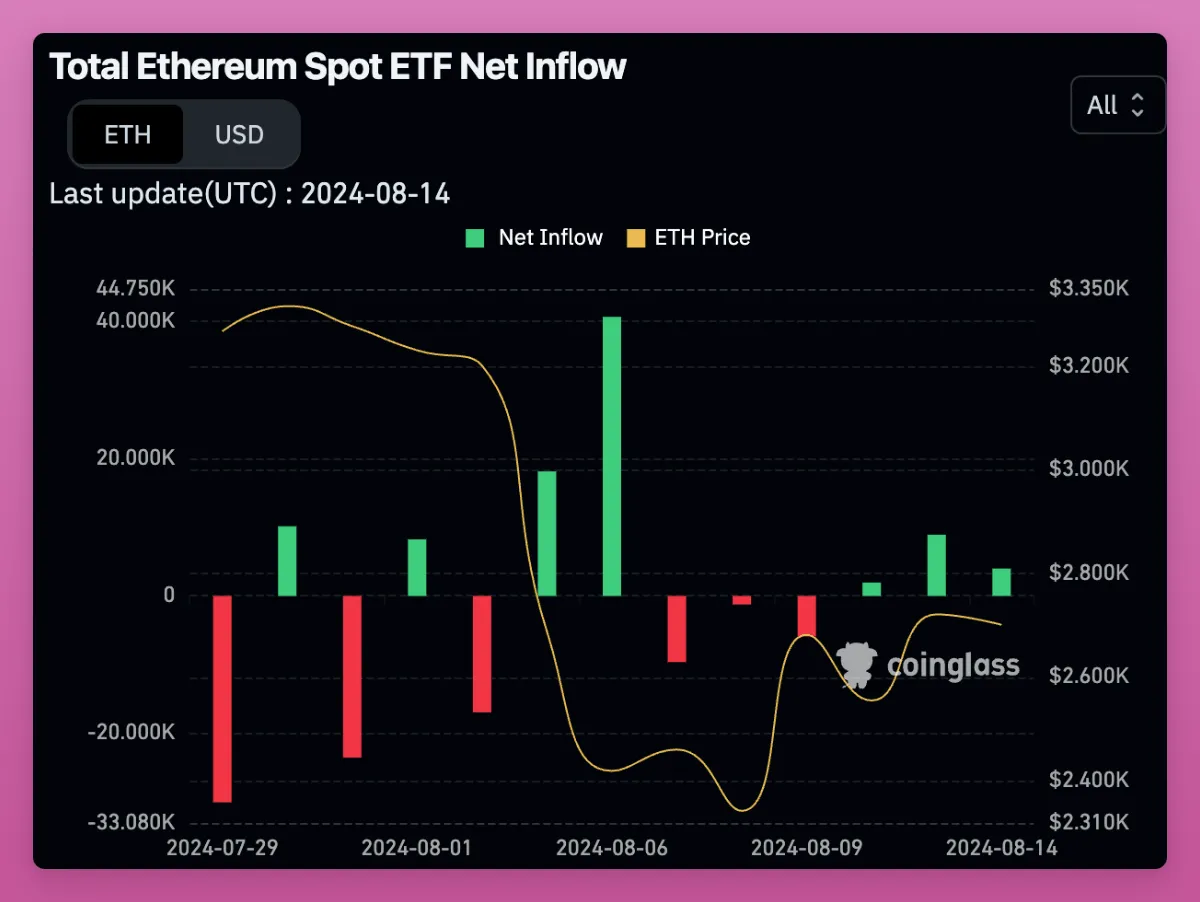
We already know the impact that Grayscale could have, but the extent of the rise would be surprising. If this trend continues, I am quite optimistic about Ethereum's future.
免责声明:本文章仅代表作者个人观点,不代表本平台的立场和观点。本文章仅供信息分享,不构成对任何人的任何投资建议。用户与作者之间的任何争议,与本平台无关。如网页中刊载的文章或图片涉及侵权,请提供相关的权利证明和身份证明发送邮件到support@aicoin.com,本平台相关工作人员将会进行核查。




